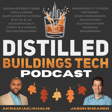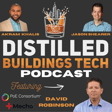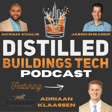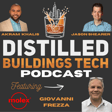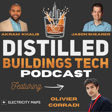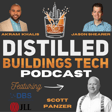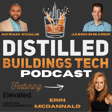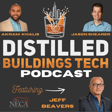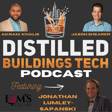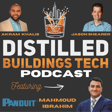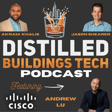Become a Creator today!Start creating today - Share your story with the world!
Start for free
00:00:00
00:00:01

Ronna Davis on the Future of Digital Electricity and Fault Managed Power
🔥 Episode Summary
In this episode, hosts Jason Shearer and Akram “AK” Khalis sit down with Ronna Davis, Chief Revenue Officer at VoltServer, to explore how Fault Managed Power (FMP) is revolutionizing the way we design, build, and power modern spaces.
Ronna shares her career journey from voice systems and network infrastructure to becoming a leader in digital electricity, and explains why she believes FMP is a once-in-a-century shift — bigger even than the move from TDM to VoIP.
From smarter, safer energy delivery to transforming how we build data centers, warehouses, and even homes, this episode dives deep into why safe power changes everything.
🛠️ Topics Covered
- Ronna’s journey from PBX systems to leading at VoltServer
- What Fault Managed Power (FMP) is and why it matters
- Why the shift to FMP feels bigger than previous tech transitions
- The impact of FMP on real estate, data centers, manufacturing, and education
- How FMP enables faster deployment, modularity, and safer spaces
- The role of AI, VR/AR, and compute at the edge in driving power needs
- How FMP complements (not replaces) PoE networks
- The future of FMP in residential homes and building codes
- Training initiatives with NECA, BICSI, and the FMP Alliance
- Ronna’s “North Star” vision: Kilowatts over a small, RJ45-like connector!
🥃 This Episode’s Cocktail
- Ronna: Vodka Soda (with fresh lemons from her own tree!)
- Jason and AK: Cheers with a refreshing summer drink in spirit 🍋
📅 Release Schedule
New episodes drop every other Monday, bringing together cocktails, technology, and smart building innovation.
🎧 Who Should Listen?
- Building owners and real estate developers
- Data center architects and MEP engineers
- Electrical and low-voltage contractors
- Smart building technologists and consultants
- Manufacturers of network and power solutions
- Anyone interested in the future of safe, scalable electricity
📣 How to Support the Show
- Subscribe on Apple Podcasts, Spotify, Overcast, or YouTube
- Leave a review and share your favorite insight
- Connect with Jason, AK, and Ronna on LinkedIn
- Join the conversation with the Fault Managed Power Alliance (FMPAlliance.org)
- Check out Voltserver at https://voltserver.com/
Transcript
Introduction to the Podcast and Guest
00:00:20
Speaker
Welcome, everybody, to the Distilled Buildings Tech Podcast. Where smart buildings are shaken, stirred, and data-driven. Awesome. So I'm your host, Jason Scheer. um your host, AK.
00:00:32
Speaker
And we are here with Rona Davis. Rona, you want to introduce yourself real quick? hey Hey, guys. ah Rona Davis. I'm Chief Revenue Officer at Volt Server. Excellent.
Rona's Favorite Refreshment
00:00:43
Speaker
Excellent. So one one tradition with our podcast is, you know, with the Distilled Buildings Tech podcast, you know, flair is to have a cocktail every time. And we generally try to ah to to cater to our guests. And Ronna, tell us a little bit about the cocktail that you is is your favorite and that you are ah that you're that you're bringing to us today.
00:01:04
Speaker
Yeah. So ah my drink, and I slightly modified it today, but my standard drink is a vodka and soda. Typically, Kettle One would be my favorite vodka with three limes. And i'm very specific about the three limes. That's how much you need.
00:01:21
Speaker
and But today I've modified it with ah lemons from my own tree. So I'm i'm doing a lemon variation of it today. and ah You know, I drink it because I do a lot of, you know, you go to a lot of work events, a lot of social events.
00:01:38
Speaker
um I can slow sip it. yeah That's one of the reasons I like It's refreshing. ah You know, it it's enough to keep me hydrated, ah but it's not so delicious that...
00:01:52
Speaker
You're slamming them. co i'm right i mean That's really why I drink it. Yeah. Well, and I, and I can appreciate like the summer, like refresher type drink, you know, you're outside, you know, whether you're by the pool or you just got some yard work done, like there's nothing better than, you know, a vodka soda or a gin and tonic to, you know, to kind of take the summer heat off.
00:02:13
Speaker
Yeah, absolutely. Absolutely. Definitely a by the pool drink. Yeah. yeah Very cool.
Rona's Career Journey in Tech
00:02:20
Speaker
um so tell tell us a little bit about your, you know but we'll definitely get into fault Server and Fault Managed Power, but tell us a little bit about like your your career journey. like You did not start in Fault Managed Power.
00:02:33
Speaker
No, I did not. I did not. Fault managed power is relatively new. And I've been been doing, been in the game for a while. So, um you know, right out of, almost right out of high school, i ended up working in ah for a small company that sold PBXs, business telephone systems. And so kind of started on the voice side.
00:02:59
Speaker
It was mid-90s. So it was right when ah like network infrastructure, everything was moving over to Ethernet from, you know, token ring systems and IBM type one and type two systems. And so ah there was an attack.
00:03:12
Speaker
ton of growth in the area, but started in but basically PBX systems for businesses that migrated into things like voice over IP, network cabling infrastructure.
00:03:23
Speaker
um And ah so I kind of moved on to a larger contractor that did large scale network infrastructure and sort of found that was what I really liked. They did all special systems, but for some reason, I just, I love the infrastructure part of it.
00:03:38
Speaker
And ah so I was in that ah portion of the industry delivering or installing ah special systems for about eight years. And then I moved to wholesale distribution for a couple of years.
00:03:52
Speaker
And then I went on to work for Comscope, a manufacturer of network infrastructure. And I was there for almost 18 years, held different roles in, you know, when I was in the contracting, I did everything from, you know, sales to service manager.
00:04:07
Speaker
on that side of it. And then when I moved over to Comscope was ah in sales, ah then moved to our global partner organization, ah worked on ecosystems, and then strategy and technology before I left.
00:04:21
Speaker
um and And then I moved on to Volt Server. I've been with Volt Server since the end of 2023. um and' I've been fortunate enough throughout my career to work with great people, have great mentors, and um really it I love tech.
00:04:38
Speaker
I do. I think, Mona, the drivers for me has always been how it improves our lives and um that ah being a part of ah technology early on where POE was just, you know, we ah you know, talking about like voice over IP, right? Like, and and, part of that happening. And I remember it feeling so hard at first, like we're not going to convince people, even though this really makes sense.
00:05:06
Speaker
And, but then it just, once it was like, once the train left the station, man, it just really moved. And that's so exciting to see how,
00:05:16
Speaker
And I don't know very many other markets, maybe healthcare care might be like that, but technology is a place where you really get to see an impact from your
Transition to Fault Managed Power (FMP)
00:05:25
Speaker
work. And I love that. Yeah. always always joke around, always joke around like how, you know, how many how many IDFs do you walk into where there's, you know, an option 11 or a PBX these days and it's like,
00:05:37
Speaker
zero Yeah. no No, it's not a thing. Yeah. Yeah. ah And it's not that long ago that it was really, that was the standard, you know, that you've, you know, you'd see 66 blocks, 110s and at all, you know, the Meridian option 11 or yeah maybe one of the big AT&T or NEC systems. Yeah. Yeah.
00:05:57
Speaker
absolutely and And you made a big change from infrastructure, which you know a lot of us would think of as passive, and then to ah an active component, which is FMP. How did that affect Rona and opportunity and and up obstacles? Did that bring any of it forward to you?
00:06:14
Speaker
Well, I never considered myself like the expert in the room. I like to be in a room full of experts and at CommScope, it was always like that, right? I mean, it's really sharp people. And so I was learning every meeting I go into.
00:06:27
Speaker
And then at VOL server, wow. I mean, it's ah the, the technology is so advanced. It it's, um it's a lot to take in technically for me.
00:06:41
Speaker
yeah But yeah, I think that while it is the active components, it still is infrastructure. you know it It really still is the infrastructure piece. it ah and i you know For me, how I even got to Vault Server is interesting because at ComScope, we were working on the development of a solution that was a fiber to the edge deployment because I'm a firm believer that we need to get there. We've got to get fiber to the user edge in buildings and campuses.
00:07:14
Speaker
um because the bandwidth demands are just going to be there. And if the bandwidth demands are going to be there, the power demands are going to be there. And so we were working on the development of a solution at Comscope's launch. It's called kind Constellation.
00:07:28
Speaker
And that's really where I got to work with the Volt server team. And ah i'm just knew that this technology was important. I knew that it was going to be really important.
00:07:39
Speaker
I sort of have a tag. This is a Rona-ism. Safe power changes everything. And I and believe it. It really does. And so i had an opportunity to to make the move. And going from a big, huge organization, I think Comscore had like 30,000 employees, you know, ah down to ah a much smaller organization, but with a technology that I think has the really does have the potential to change everything.
00:08:07
Speaker
And maybe tell the audience, what's what's the definition of of FMP from Rona's perspective? Because they're going to hear Mahmoud's and I want to hear from you. What's what's f and p What does it stand for?
00:08:18
Speaker
What does it do?
Understanding FMP's Global Impact
00:08:20
Speaker
Yeah, so FMP fault managed power, that's, you know, and then, you know, really by definition, it is a connected power system that is able to um monitor a circuit for faults and limit the amount of energy into ah into a fault on that circuit.
00:08:42
Speaker
And what does that mean? Well, that means that it's safe for people to interact with. It means that it doesn't start fires. And so ah what that, you know, my moniker safe power changes everything.
00:08:57
Speaker
Well, now if power is safe for people to interact with and it doesn't start fires, that changes where we can install power, how power can be installed and who can install it and work with it.
00:09:12
Speaker
ah And when you look at energy and energy being one of the main constraints for, um ah for economies, right? Like ah the ability for an economy to grow, ah ah that access to energy, that's that constraint, right? How hard it is to build these big, to build power, to get power distribution, ah power generation, and then to get power distribution to where people can use that power.
00:09:41
Speaker
um If we can make that easier, fault managed power can make that easier, then um I see that it really does um have the potential to release trillions, trillions of dollars of of value throughout the world.
00:09:56
Speaker
um And so I guess that's that's what it is to me. it's It's power that is safe for people to interact with. It's significant power. I think that's an important piece to make too, because you talk about PoE and PoE is also a great connected safe technology, but it has power limitations, has some distance limitations, right? or Fault managed power is significant power and it can go pretty significant distances as well.
00:10:19
Speaker
Yeah, a couple of weeks ago, people will have heard from from Andrew and Andrew Liu, like you've probably heard him talk about, you know, his DC donated viability, you know, where yeah at the megga at the megawatt level, it might be like ArcSafe DC and then FMP and then PoE. And like each each one of those, um those like kind of like layers of the onion, like has its own its own economics. Yeah.
00:10:41
Speaker
what be i would I would like to hear, like like do you said, the the where, the who, and the and the how. But first, do you think, like having gone through you know big big technology transitions like TDM to voice over IP, does this does this kind of does it feel the same like as far as the opportunity?
00:11:03
Speaker
feels bigger.
FMP Compared to Past Tech Transitions
00:11:05
Speaker
Yeah. it feels like the song in the back of my head, Jason is, feel the earth move under my feet. That's, that's it. Like it's, it's bigger because,
00:11:20
Speaker
um And I love data. I love data. I love data systems. ah But for all data systems, you need power too. So, and this is obviously it's beyond data, right? What we can power isn't just powering data systems, although almost everything's gonna, you're gonna want data from pretty much everything we already do.
00:11:41
Speaker
um But I feel like it's, it's bigger.
00:11:47
Speaker
Got it. and And the two like two inflection points I see are we're still in this this this real estate reconfiguration, rationalization inflection point.
00:12:00
Speaker
And then on the other side of that push and pull, we have AI, right? and Like ai is going to be superpower hungry. Like how do you how do you see both of those like playing into the the demand for f and p Yeah, you know, think that as this office space gets reworked, and I think some of it that's happening now, right?
FMP in Office and AI Power Needs
00:12:19
Speaker
um That the utility of fault managed power to be, um it's more modular ah modular, it can be deployed faster, ah um it's intelligent, right?
00:12:34
Speaker
um It's gonna make reworking the spaces easier, um one. And then I think as we're reworking these spaces, I'd like to see more fiber to the edge so that we're able to support AI and along.
00:12:49
Speaker
And so, you know, virtual reality, augmented reality, ai those analytics. um um I think we're probably likely going to need some compute at that very edge, more devices with compute built into them. That means there's going to be more power demand out there, but we're still going to want to send a lot of um data back onto the network, as which is why I think that we're going to need fiber for it.
00:13:11
Speaker
And so I think as spaces are reimagined, um that fault managed power will be a great tool ah to enable those technologies that are going to really transform the buildings and it and the workspaces, I think, ah pretty significantly over the next 10 years. so and what What industries or at least type of projects do you think that are most relevant for FMP today? we we know it's already been deployed.
00:13:37
Speaker
And what others that are lagging still that ah needs to catch up or maybe not ready for FMP today? Yeah, so, um you know, Vulture has over a thousand installations. I think it's, we're approaching about 50,000 circuits out there powered with fault managed power. So, ah but there are areas where it's easier, where, you know, the the the transition or the movement towards fault managed power is easier.
00:14:03
Speaker
ah And some of the, you know early on, we've seen a lot of us success within telecommunications networks or powering cellular antennas. basically.
00:14:15
Speaker
DAZ, like um inside of like big stadiums and facilities, right? Yep, that's right. those Those antennas that require more power than what's available for PoE or they're really, really long distances because of the type of ah building that we're working in.
00:14:31
Speaker
ah So I think that the areas where the most immediate value is seen is in those environments that have long horizontal spans. So ah distribution facilities, big box retail, manufacturing,
00:14:44
Speaker
very strong use cases for fault managed power.
Industries Primed for FMP Adoption
00:14:48
Speaker
Now, along in a lot of those spaces right now, they're all undergoing ah um through a retool, right? This industry 4.0, and they're introducing a lot more automation and robotics, and all of those things are going to require more power. They're also going to um create more...
00:15:06
Speaker
um ah more diverse workspaces or workspaces that they're going to want to be able to reconfigure. And that will bring a lot of value, I think, too ah to those facilities.
00:15:19
Speaker
So I think that's one of the areas where the use case very, very strong because they have long horizontal distances. ah They do need significant power and automation, things like robotics, AI, and augmented reality solutions are are prevalent.
00:15:38
Speaker
And then, um, uh, and then beyond that, I, I really do think that the office space, um, because of the rework as the office space is being reworked, um, universities and education, education is really going to be able to take advantage of ai and, uh, virtual reality, uh,
00:15:58
Speaker
So getting fiber and more power into the classrooms, I think is important. Uh, and then uh, And then looking out just a little further is um is data centers. and And when I say a little further, I don't mean really far out.
00:16:14
Speaker
I mean in a couple years ah that we've gotten to the point where the technology can support significant power, ah that where we can play in a data center space and and even um being able to power hundreds of kilowatts in a rack.
00:16:32
Speaker
ah And a lot of the reason why for fault managed power, it's it isn't that much of a reach ah for for us is because we don't have all of those encumbrances, safety encumbrances that have you have to put around electrical that um take up a lot of space.
00:16:49
Speaker
They do. And space, obviously, within the data center is you know, is the highest value. And so If they're going to have this level of compute they need in this small of a format, you need power that can be in a smaller format.
00:17:04
Speaker
And fault managed power does that. So ah when I look at ah what's coming out there, and I call it my North Star, which is ah getting fault managed power directly into power supplies in the servers.
00:17:19
Speaker
Where at that point, it's something about the size of an RJ45 that plugs into the back of a server and is delivering um you know kilowatts of power and can be deployed like a structured cabling system. I've got i gotta to go back to my structured cabling roots. I can't help it. Because it is so important. Infrastructure is so important because it offers flexibility, right? And um now with this small form factor power that's high density that can be delivered in a pre-terminated format that's modular, i mean, the value proposition there is, it in my view, it's the...
00:17:56
Speaker
um the value proposition is probably the best, but we're, we're still, we're couple of years, but it's there. It's it's very real and very exciting.
00:18:09
Speaker
I do agree with you, Rona, because I think when you said that the opportunity is bigger, this has not been done in the past. the Hundreds of years, we've been delivering power the same exact way to the edge. And today, yeah what you just said, there is an opportunity for an infrastructure or an RJ45-looking cable that delivers kilowatts worth of power.
00:18:28
Speaker
This has not been done before. This is new cutting-edge technology that's going to change the way we build and deliver power forever. Forever. Yeah. No, I think it's, and then, you know, you look way down, you know, you ah down the line further.
00:18:44
Speaker
um But I think about how um AI, ah you know, it's digital power,
FMP's Future in Data Centers
00:18:50
Speaker
right? And now let's put some AI on it. And what does that do? How much smarter does the system get? How much more efficiency can we ah can we build in? And I think that there's um yeah there's There's just so much, so much potential.
00:19:05
Speaker
But, you know, I would kind of say in that order, look, we, that that warehouse distribution, manufacturing, big box, retail, long horizontal spans. I don't particularly like that term low hanging fruit, but I'm going to use it.
00:19:16
Speaker
That's kind of low hanging fruits, very obvious, you know, ah the value proposition and they're already so ah um akin to DC technologies in those spaces anyway, they prefer it.
00:19:29
Speaker
And then I think the rework of our buildings and campuses, I think, is a great opportunity. um and And then data centers. In terms of value, that's where power density is, right?
00:19:41
Speaker
so um ah and so that And that North Star being right to the... right to the power supply. Because right now, the way that the systems work is you have a transmitter and you have a receiver connected by a cabling.
00:19:57
Speaker
That receiver takes the fault managed power in and then converts it to a traditional power type. So it can you know converts it to 48 volt DC, 56 volt DC, AC power or high voltage DC.
00:20:10
Speaker
um And and then then you use that that connection into a traditional device. ah When we look at the data center, i think about that power supply now, instead of having to do ah like a AC or a high voltage DC um plug, which is quite large, right? you know And everything to make it safe so people can work with it, quite large.
00:20:34
Speaker
Now all of a sudden it's just fault managed power directly into that power supply. I mean, just like your knit card, just like plugging into your knit card guides, just like that is, it yeah. And you think about this like this, like the safety component of it, because these these data center racks, like traditionally we've we've thought about, you know, eight kilowatts in a rack being a lot, but now we're going to 50, 140 and NVIDIA's projection, like in three years is like,
00:21:03
Speaker
600 kilowatts in a single rack. And so now in order to achieve that, we're going to have to start doing either on die or immersion cooling. And that just raises the bar on like electrical safety. So it's it's almost like we have to have some sort of a new technology to ensure data center, you know, dorky little data center engineers aren't getting electrocuted.
00:21:27
Speaker
Yeah, no i the no, you're right. we're Now we're introducing liquid in places we've been trying really hard to make sure liquid didn't. water out, yeah. um And so there's the safety element. There's the space element, too, because now you have to have plumbing systems that you have to account for. There's a whole building subsystem now that we have to pipe to the rack.
00:21:48
Speaker
And so I, yeah, I completely agree. And a couple of years ago, ah Steve did a demonstration, Steve Eves. He's the, he's in Steve Eves is the inventor of fault managed power and he's our CEO.
00:22:01
Speaker
And a couple of years ago at DCD, he did a demonstration with fault managed power in a fish tank. Yeah. Right. And I think, it you know, he he was trying to get the point across. Look, we heard you guys are going to put water in your data centers. Let's talk about it.
00:22:18
Speaker
and And so I think it's a great point that you bring up, Jason. yeah it's Yeah, were we' we've got water in the data center now. so Bronagh, you talked about some limitations of POE, and we hear this from the audience and
Will FMP Replace PoE?
00:22:32
Speaker
a lot of comments. Is FMP going to change or replace POE?
00:22:38
Speaker
No, man, it enables it. It enables POE. Look, there's most devices in the building require less than 100 watts of power. Why would you not use POE?
00:22:52
Speaker
it's you know It's a smart technology, right? You're able to capture capture data. You're able to cycle power remotely on those devices. um The cost models for PoE are great. There's plenty of electronics that are available now on the market if you wanna embed PoE as a technology into your endpoint device.
00:23:10
Speaker
ah So i see fault managed power as a way to make it easier to deploy PoE. bill Now, I would just say, so some people say FMP is the backhaul to...
00:23:23
Speaker
POE. And I agree that it is. But I also think there's other there's other things in the building that we're going to power with FMP that exceed the power, um you know, the power capability of POE. So I know I actually see it as a great enabler um as to being to be able to deploy more POE to edge devices.
00:23:47
Speaker
And for our audience that that are probably not living in buildings and and want to see this technology at their home, when do you think FMP would actually make it to the consumer level, if it ever will?
00:24:00
Speaker
Yeah, I i do think it will, because if you've noticed the thing about the, at least in the, we'll talk about the US, right? Because and I'm only dangerously oriented to any other building codes outside of the US, but you know the code has been progressively more safe, especially as it pertains to residential consumers.
00:24:22
Speaker
um And I think that's the way, the direction it should go. That should actually absolutely be their directive. And ah so ah while the inclusion of fault managed power for the 2023 NEC didn't include residential, I believe it is in the 2026 going to be included, the um the ah The use of fault managed power in residential and making power safe for the residential consumer, I see as ah it's a no brainer. It'll happen.
00:24:53
Speaker
um the The biggest obstacle with getting there, like, you know, getting to that point is really the technology being embedded into endpoint devices, right? So, ah you know, where, um and what is that distribution going to going to look like? Are we going to, is it going to mean more POE to to outlets, you know, powering more things? And then ah the FMP powers the PoE, is it going to be that we've got FMP circuits that now go to different appliances and devices, and then those devices have FMP embedded inside of inside of them?
00:25:33
Speaker
um But you have to have interoperability. you know You've got to have some things before that can really be real into that market. um But I absolutely think the value is there. They're doing all kinds of things to reduce fire risk in buildings right now.
00:25:49
Speaker
um in the jurisdiction that I live in in Henderson, Nevada, new, new single family residential has to have a sprinkler system
FMP's Residential Potential
00:25:57
Speaker
inside of it. Yeah. yeah it Yeah. and we oh wow Yeah. Like a fire sprinklers in a single family residential, there may be a square footage, you know, distance, but, um, it,
00:26:10
Speaker
I know that it affects like a midsize single family residential home where historically you've only needed that in multi-tenant. well um So things like fault managed power are going to red reduce ah reduce the risk of fire.
00:26:24
Speaker
um That's going to be better for insurance premiums. It's going to be better for the health and safety of the occupants of those buildings as well. So i I see it as a no brainer, but I do think that there are steps along the way in an adoption from an adoption standpoint um to to get there.
00:26:42
Speaker
and And it's a it's a pretty it's a disruptive technology, right? Like it's very different than how we've designed and built, you know, buildings and homes and. conferences and trade centers for the past 150 years. And now I think we're this publishes on on June 30th. So we will have had Cisco's big Cisco live and in San Diego a couple of weeks ago.
00:27:05
Speaker
and in planning for that, All the trades were like, whoa, whoa, whoa, can't bring this in here. um We had some some manufacturing robots on the on the show floor that were 48 volt powered, like some FANUC robots.
00:27:19
Speaker
And we're like, yeah, you can just power those off of a FMP receiver. They're like, no, we can't. We're like, well, 48 volts is 48 volts, right? There's no difference. So a lot of a lot of this is just overcoming you know fear of new technology.
00:27:33
Speaker
Yeah, and I think, you know, when you think about the electrical industry where it's different than, you know, you get something new on your iPhone and, you know, that's great. But a lot of the electrical industry is built on safety, right? So you have a ah group of people who their responsibility was to make sure people did not get electrocuted, buildings did not burn down, right? And so um respect the pushback.
00:28:01
Speaker
You know, the, that they want to learn and they want to understand and they want to make the right decision. And I respect that. That's why they're there. Right. That's, and, uh, uh, but technology is safe.
00:28:13
Speaker
It is safe guys. And, uh, and it's going to, um, it is going to change things. And the ecosystem is, uh, not, um,
00:28:26
Speaker
They're not adverse to the change, I wouldn't say. ah Overall, there's a lot of interest and a lot of support in moving things forward. But ah it certainly is um a rock that
Promoting FMP Education and Standards
00:28:41
Speaker
we're pushing, right? It doesn't move fast because, I think because of the safety element of it and because of that the the people within that industry, their careers is are is built on and the safety and security of building ah building occupants and assets.
00:28:57
Speaker
So I do see it um as, I don't see them as like really holding it back so much as help us understand, right? Yeah. A lot of education. They're doing their delusions.
00:29:09
Speaker
And I think think, Rona, from your perspective, Volt Server and others are doing some of that to educate the market. Why don't you tell us some of the initiatives that you guys are doing on the FMP side to make sure that you spread the message, right? It can't be one company. I think there's a whole alliance that actually moves the end standards and and the mission forward. So that way...
00:29:30
Speaker
people that are sitting back and looking at this to can understand what's you know what they're expecting and and what does FMP mean for the industry? Yeah, so we're ah one of the founding members of the FMP Alliance. So a group of stakeholders, um Bolt Server, Cisco, Panda, Prisman, Belden, we formed the FMP Alliance.
00:29:54
Speaker
and And now it's grown. There's additional members since then yeah with the core mission of educating the market and moving towards more standardization and interoperability. Now, we're not a standards group, um but as a collective, we can help to move forward, move those things forward within the standards bodies and the code making groups.
00:30:14
Speaker
And so we see that within the FMP Alliance. It's a relatively new alliance, but we're getting our feet underneath us and ah working with other industry trade groups ah that are supportive so we can bring, you know, kind that whole message to,
00:30:31
Speaker
two to the market. And then Volt Server, we do a lot of work with NECA and the Electrical Training Alliance, the JATCs, because it's important that people know what ah the technology is, they understand what are the installation requirements,
00:30:52
Speaker
And so we do a lot of that work. We also are doing work even with universities, right? And um ah talking to to their groups there because you've got to start to incorporate this understanding and this knowledge base into the training programs for these electrical engineers, right?
00:31:10
Speaker
So there's work that has to be done there as well. And then we work with organizations like Bixie. on getting training and um getting in front of audiences to teach them about the benefits of it, but also just the general understanding of how these systems work and how they need to be installed and managed.
00:31:29
Speaker
Yeah, I think that's that's that's a novel approach um that we're all taking of like coming from both sides of the problem, from the low voltage side, from Bixie. I know that's that you and I got to spend some time together and um in in January and in um and Orlando.
00:31:43
Speaker
And then a little a little teaser for a future episode. We have Jeff from from Nika coming on and in a couple of weeks to talk about how how he's trying to approach it from a...
00:31:54
Speaker
a certified electrician, like high voltage electrician side. So it it definitely it definitely takes a village to to get everybody enabled on on new new technologies and standards.
00:32:07
Speaker
Yeah, definitely a lot of interest, though, from from all of those the different industry associations or trade groups. The interest is there, and I applaud them for that. They're proactive in you know coming to us and asking us for the information, help help us get trained so that we've we've got the labor force and that customers want to use to deploy, help manage power. Yeah.
00:32:32
Speaker
that's and um I was at a consultant forum with and and another FMP vendor in Chicago um a a month or so ago with and MEP firms, cabling contractors. And I think that there they're even still trying to figure out, like is that something that the comm side specs out and works on? Or is that something that like the traditional electrician side works out?
00:32:56
Speaker
how How have you seen that actually going down in projects? So I think it's going to go in phases. And I actually believe it's going to be shared. Ultimately, I believe it's going to be shared based on the application.
00:33:10
Speaker
And ah it's if you are designing ah data systems, right? So i like the current orientation of the technology, like right now today, I would say we power networks.
00:33:25
Speaker
Really think about it. no Networks, we power networks and some building subsystems. That's the way we power. And so I think that as long as within the space of powering networks, I think a lot of that's going to be done by lo ah through the low voltage design.
00:33:39
Speaker
right ah Now, each state's going to make up and decide how they categorize things and whose stamp needs to be on it and who pulls the permit. But generally speaking, I think it's probably going to be in low voltage design as long as we're powering networks.
00:33:53
Speaker
As we move beyond that and we're powering um mechanical units, like we've you know powered ah you know a train air conditioning unit and some you know some split systems or ah powering some stoves and doing things like that. Well, then I think that is squarely on ah the ah the more traditional electrical side.
00:34:14
Speaker
So I think it's going evolve to include both. I think in the short run, ah we are most of what we're doing today is powering networks. So that makes sense. Data center, we're going working with the electrical engineers.
00:34:25
Speaker
ye
00:34:28
Speaker
If I'm designing an FMP project or I want to learn about Volt Server, where do I go? Where do I find information about Volt Server and Rona?
Resources and Upcoming Events
00:34:36
Speaker
Yeah, well, so you can go to voltserver.com.
00:34:39
Speaker
and That is our website. And then please reach out to me on LinkedIn and my... um on my LinkedIn page would love to connect with anyone that's interested in fault managed power.
00:34:54
Speaker
Um, also if, if you're a company out there and you would like to learn more about fault managed power, generally you believe your company may have a, um, a product or either developing products or supportive products, um join the FMP Alliance, right? ah Because, and and that's fmpalliance.org because we're we're starting to do some great work in that in that we need more manufacturers, we need more engineers involved there.
00:35:21
Speaker
And we actually want end users there as well because we we think it may be very helpful to have a user group talking about the different ways that they're deploying fault managed power Having a peer group within the FMP Alliance of Users, we think may be very helpful for people that are considering fault managed power for their organizations.
00:35:43
Speaker
Yeah, cool. and And then we spent some time in in Savannah together at RealCom. But where where else will Volta be showing up like throughout the summer and like and into the fall from, you know, from a conference and a trade standpoint?
00:35:57
Speaker
Yeah, so we will be presenting at NECA, potentially at Bixie. I think we're all sort of waiting to hear back on the final ah yeah the final plan for Bixie.
00:36:08
Speaker
um But next week, actually, i have a Bixie webinar ah that I'm conducting on April 30th. um And it's on really the market opportunity for fault managed power. Like it's kind of some of this, but, um you know, less less cocktail and more slides. Yeah. And Nika will be interesting this year too, because it's in, it's in Chicago. And we all know that like Chicago is a very, uh, I think ah somebody at Cisco said the other day, the U S has a fetish with conduit. Like Chicago has a serious fetish with conduit. So it'll be cool to have, uh, to have the Nika conference up there where, um,
00:36:55
Speaker
it's an even more difficult market to to disrupt. Yeah. Yeah. No, i'm I'm looking forward to it. And I think Steve and I will be at the Nika event. Awesome. Awesome. That's awesome.
Conclusion and Social Media Follow-up
00:37:06
Speaker
As usual, you know, for the audience, like, and subscribe, you know, follow us on all social media. But I think Rona, it's a pleasure to have you. It's always great to see you. Thanks for the the recipe. Definitely a great cocktail.
00:37:19
Speaker
All I appreciate it. Thank you guys. It was great. Great chat. Yeah. and See you guys. Cheers.
